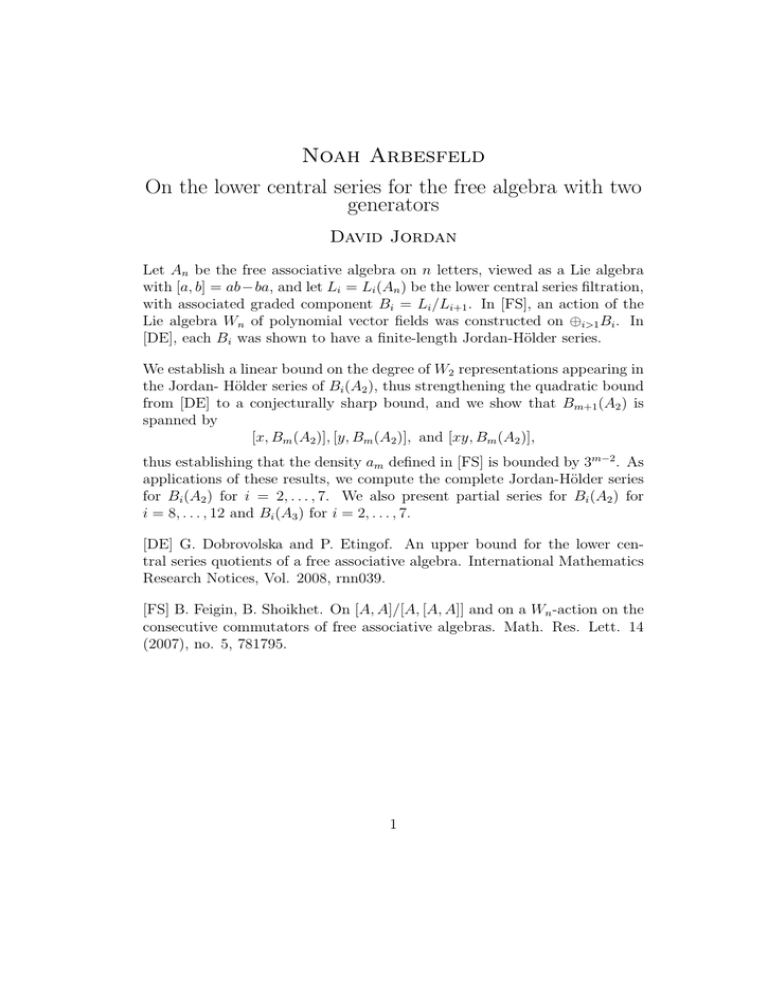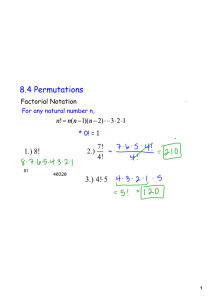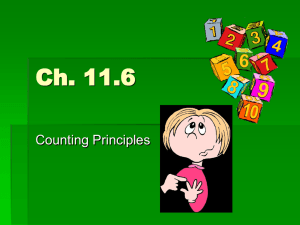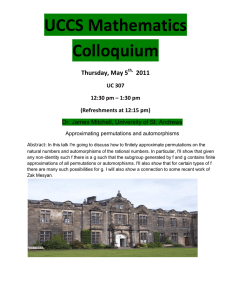Noah Arbesfeld generators David Jordan
advertisement

Noah Arbesfeld
On the lower central series for the free algebra with two
generators
David Jordan
Let An be the free associative algebra on n letters, viewed as a Lie algebra
with [a, b] = ab−ba, and let Li = Li (An ) be the lower central series filtration,
with associated graded component Bi = Li /Li+1 . In [FS], an action of the
Lie algebra Wn of polynomial vector fields was constructed on ⊕i>1 Bi . In
[DE], each Bi was shown to have a finite-length Jordan-Hölder series.
We establish a linear bound on the degree of W2 representations appearing in
the Jordan- Hölder series of Bi (A2 ), thus strengthening the quadratic bound
from [DE] to a conjecturally sharp bound, and we show that Bm+1 (A2 ) is
spanned by
[x, Bm (A2 )], [y, Bm (A2 )], and [xy, Bm (A2 )],
thus establishing that the density am defined in [FS] is bounded by 3m−2 . As
applications of these results, we compute the complete Jordan-Hölder series
for Bi (A2 ) for i = 2, . . . , 7. We also present partial series for Bi (A2 ) for
i = 8, . . . , 12 and Bi (A3 ) for i = 2, . . . , 7.
[DE] G. Dobrovolska and P. Etingof. An upper bound for the lower central series quotients of a free associative algebra. International Mathematics
Research Notices, Vol. 2008, rnn039.
[FS] B. Feigin, B. Shoikhet. On [A, A]/[A, [A, A]] and on a Wn -action on the
consecutive commutators of free associative algebras. Math. Res. Lett. 14
(2007), no. 5, 781795.
1
Kristin Cordwell
On G-Difference: A Property of Permutations and
Words
Joel Lewis
Consider a simple graph G labeled with distinct positive integers so that
a vertex v is labeled nv ∈ N. Let x = (x1 , . . . , xn ), y = (y1 , . . . , yn ) be
permutations of 1, . . . , n. If for some 1 ≤ i ≤ n, xi = nv and yi = nw so that
v and w are two vertices of G joined by an edge, we say (following Körner,
Malvenuto and Simonyi [1]) that x and y are G-different. The maximum
number of pairwise G-different permutations of length n is denoted κ(G, n).
Various bounds of κ(G, n) on permutations for general and specific G were
described in [1]. In this paper we continue the construction of bounds on
permutations of κ(G, n) for specific graphs G. We also look at κw (G, n), the
maximum number of pairwise G-different words of length n for a graph G.
We construct general bounds for κw (G, n) as well as evaluate κw (G, n) for
specific G. Finally, we relate κw (G, n) to χf (G), the fractional chromatic
number of G.
2
Miles Edwards
2-Sylow subgroups of ideal class groups of imaginary
quadratic fields
Liang Xiao
√
If K = Q( −D) is an imaginary quadratic number field, we use Cl(−D) to
denote its ideal class group, which is a finite abelian group. Cohen-Lenstra
heuristic suggests that if we pick a random square-free D, the probability of
p-Sylow subgroup of Cl(−D) to be a fixed group G is inverse proportional to
#Aut(G). This heuristic was conjectured for odd prime p’s and was known to
fail for p = 2 because the genus theory can compute the number of 2-torsion
elements which apparently does not match the conjecture. We computed the
2-Sylow subgroups of Cl(−D) up to D = 106 , using the theory of binary
quadratic forms. Then, we sorted the class group according to the number
of 2-torsions. The experimental data showed that if we fix the number of
2-torsion elements, the distribution of some 2-Sylow subgroups matches the
prediction by Cohen-Lenstra heuristic. However, there are also some mysterious numbers which cannot be explained by Cohen-Lenstra heuristic. We
plan to work on this after the RSI.
3
Katrina Evtimova
Representations of Rational Cherednik Algebras of
Rank 1 and 2
Emanuel Stoica
This paper deals with the classification of finite dimensional irreducible representations of the rational Cherednik algebra Hc (W ) over a field k depending
on some parameters c ∈ k and an indecomposable reflection group W . We
analyze the case when W is any group of rank 1 or a certain group of rank
2. In rank 1, namely W = Z/rZ, we complete the classification that was
started by Latour, analyzing the case when char k divides r. In rank 2, we
study the case when W = S2 n (Z/rZ)2 and char k = 0.
4
Hyun-Sub Hwang
Permutations with a Special Property and their
Extension to Abelian Groups
Joel Lewis
A permutation of a finite set is an ordered list containing each element of
the set exactly once. Inspired by a question from the 1995 Russian Mathematical Olympiad, we call a permutation a1 , a2 , . . . , an of 1, 2, . . . , n a “good
permutation” if it has the property that {a2 − a1 , a3 − a2 , . . . , an − an−1 }
equals the set {1, 2, . . . , n − 1} when taken modulo n. We prove that the
number of good permutations of length n is divisible by 2nφ(n), where φ(n)
is the Euler totient function of n (i.e., the number of positive integers less
than and relatively prime to n) and provide some bounds on the number of
good permutations of length n for each n. We also extend the notion of a
good permutation to any finite abelian group and prove the following simple
condition for the existence of good permutations of an abelian group:
Theorem. An abelian group G admits a good permutation if and only if,
when G is written as a product of cyclic groups of prime-power order, exactly
one of the factors is of even order.
5
Eric Larson
Fusion categories of dimension qp2
David Jordan
Let G be a group with square order. We consider the fusion ring RG obtained
by adjoining to ZG two additional elements 1, 2, with multiplication table
g
1
2
h gh p 1
2
P
1 1
|G|2
p g∈G
P
2 2
|G|1
g∈G
RG is a Z/3Z-graded fusion ring with trivial component ZG. We classify
the categorifications of the fusion rings RG when |G| is not divisible by 3,
and achieve an explicit construction when G = Fnp for p > 3. Our results
generalize those of Tambara and Yamagami and provide a key step toward
the classification of fusion categories of Frobenius–Perron dimension qp2 .
6
Paul Lee
Modelling Salt Effect on DNA Conformations
Xia (Carol) Hua
We represent circular DNA in the simple cubic lattice in order to model
the effect of salt concentration on its topological and geometric properties.
Chemically, a high salt concentration weakens the DNA’s electrostatic bonds
allowing for DNA to adopt a highly compact state, with the bending and
writhing energy dominating over other energies. A short-range attractive
force between non-adjacent monomers, DNA’s nucleotides, and a screened
Coulomb potential to gauge the forces between the monomers with a salt
variable are in the potential energy model. The radius of gyration, contact number, and writhe were considered to test for overall compactness and
complexity of the conformation of DNA. All results verified that an increased
salt concentration increases compactness, thus contributing to higher knotting probabilities.
7
Patricia Li
On the number of permutations with a given number of
cycles and left-to-right maxima
Matjaž Konvalinka
Foata’s transformation gives a bijection between the permutations with p
cycles and permutations with p left-to-right maxima. R. Cori recently found
a bijection between the permutations with p cycles and q left-to-right maxima
and permutations with q cycles and p left-to-right maxima. We implement
his bijection in Java, and study its properties. Our results are about the
fixed points of this bijection. Our main theorem states that the number of
fixed points of the bijection for n is equal to the number of involutions of
length n.
8
Zane Li
On the intersection of quadric and cubic surfaces
Ryan Reich
Projective space, RP3 , is obtained from ordinary space by including as a
“plane at infinite distance” the points on the horizon of each flat surface;
thus, every direction (a line) terminates at a unique point on the plane at
infinity. Complex projective space, CP3 , is the space in which every complex
“line” (a copy of the plane of complex numbers) in C3 terminates at a complex
“plane” at infinity. One defines surfaces in CP3 using polynomial equations
such as xy = zw with four variables, in which all terms of the same degree;
for a polynomial of degree 2, the surface is called “quadric” or “quadratic”,
and for one of degree 3, it is “cubic”. The intersection curve between two
quadric surfaces in CP3 is of fundamental importance in computer graphics
and solid modeling. Its features have been studied extensively in [2] and
[4]. These features include the “pencil” of quadric surfaces which surrounds
the intersection curve, and the projection of the intersection curve onto the
plane at infinity. In this paper, the corresponding properties are studied for
the intersection curve between a quadric and a cubic surface, and results are
obtained for a family of cubic surfaces, the analogue of the quadric pencil.
[2] R.T. Farouki, C.A. Neff, and M.A. O’Connor. Automatic parsing of
degenerate quadric- surface intersections. ACM Transactions on Graphics 8
(1989), no. 3, 174-203.
[4] W. Wang, B. Joe, and R. Goldman. Computing quadric surface intersections based on an analysis of plane cubic curves. Graphical Models 64
(2003), 335-367.
9
Xiao Tian Liew
Predominant intersection vertices in spanning trees
Maxim Maydanskiy
Given a graph G = (V, E) and vertices a, b, e ∈ V , we find out how a, b, e
are connected in G using the spanning tree approach. For a spanning tree
t ⊂ G, we find the earliest intersection vertex j between the unique paths
from a to e and from b to e, and say that t “votes” for j. We seek to
determine the number of votes a given vertex gets, and in particular to find
the vertex with the most votes in G. We obtain some results for complete
graphs and complete bipartite graphs. This problem can be generalized to
directed weighted graphs, and has applications to drug delivery.
10
Young Wook Lyoo
On The Linear Extensions and Interval Extensions of
Poset
Yulan Qing
Let (P, ≤P ) be a partially ordered set(denoted poset). An extension of (P, ≤P
) is a poset (Q, ≤Q ) such that
1. Q = P , and
2. if a ≤P b, then a ≤Q b.
The underlying set of an extension of a poset does not change. An extension
Q of P is said to be linear if Q is a linearly ordered set. An extension Q of
P is said to be an interval extension if each element of Q is a closed interval
on the real line, and x = (a1 , b1 ) ≤ y = (a2 , b2 ) iff b1 ≤ a2 . An intersection
of two extensions is a poset such that x ≤ y if and only if x ≤ y in each
extension. A set of extensions realizes a poset if and of if the intersection of
extensions is isomorphic to the poset. We define Sm , n to be the set of posets
that can be minimally realized by a set of m interval extensions and n linear
extensions. In this research we study the containment of Sm , n with different
values of m and n. We prove that Sx , y ⊆ Sz , w if and only if 2x+y ≤ 2z +w.
11
Benjamin Mirabelli
Finding non-degenerate critical points of the
superpotential associated to a smooth Fano plytope
Maxim Maydanskiy
Toric varieties are studied extensively in algebraic geometry and symplectic
topology. It is known that such a variety is encoded in a polytope, with
Fano varieties - a particularly nice class - corresponding to reflexive lattice polytopes. Information about symplectic topology of the variety can
be retrieved from the superpotential - a Laurent polynomial associated to
the corresponding polytope. Critical points of the superpotential, and nondegenerate critical points in particular, are of special importance. We prove
that the superpotential of any polytope that is either the convex-hull product
or the Cartesian product of two polytopes whose superpotentials only have
non-degenerate critical points also only has non-degenerate critical points.
From this we show that every critical point of every facet-symmetric smooth
Fano polytopes superpotential is non-degenerate.
12
Dimitrios Papadimitriou
Factorization in terms of Cyclotomic Polynomials and
Algorithms for their Coefficients
Tathagata Sengupta
In this study, we find two algorithmic methods to improve on an existing
description of the coefficients of the cyclotomic polynomial Φn (x) when n is
the product of two primes. We use Beiter’s description which refers to the
representability of n as n = ap + bq and n = ap + bq + 1 as a criterion to find
the coefficients of Φpq (x), where p, q are 2 primes. In our first method we use
inequalities, while in the second devise an algorithm using congruences. In
essence, with our second algorithm, we can read off the coefficients as soon
as we have written out the ap (mod q)’s as n (mod q)’s for 0 ≤ n < q. This
method, in particular, gives a very easy description for the coefficients when
p ≡ ±1 (mod q).
Furthermore, we investigate which polynomials can be written as a product of cyclotomic factors. In particular, we find a characterization of all
polynomials of a given degree with odd coefficients, which can be written
as such a product. These are also the only polynomials that have Mahler
measure 1. We make iterated use of Graeffe’s root powering method, check
that we always have a fixed point for these, and use these fixed points to get
a very precise characterization for these polynomials. This also describes an
algorithm for finding all these polynomials explicitly.
13
Eliyahu Putterman
Determination of the Rate of Convergence of the
Equi-Energy Sampler
Xia (Carol) Hua
The equi-energy sampler of Kou et. al. is a new sampling algorithm that aims
to circumvent the problem that high energy barriers present to Markov chain
Monte Carlo methods for sampling from complex Boltzmann distributions.
To test this claim, we simulate the equi-energy sampler and the standard
heat-bath algorithm on the Potts model and compare their correlation times.
Our data suggest that the equi-energy sampler does not offer a significant
performance improvement over the heat-bath algorithm in the case of the
Potts model.
14
Maxim Rabinovich
On the Scaling Limit of a Generalized Divisible
Sandpile Model
Emanuel Stoica
Internal DLA is a way to generate a region from a discrete random walk.
Levine and Peres have shown that these regions converge, with probability
one, to the same limit as those produced by a deterministic process known
as the divisible sandpile and that the limiting shape is given by the solution
to the obstacle problem. In this paper, we consider a more general version
of the divisible sandpile and prove that it converges to the solution to a
different obstacle problem. This research is a first step toward determining
what happens in the most general kind of divisible sandpile model. It is also
likely that our methods can be extended to determine the scaling limit of
certain generalized internal DLA models.
15
David Harry Richman
Counting diagonal matrices over finite fields
Tonghoon Suk
Matrix diagonalization is a useful technique in studying linear transformations, discrete dynamical systems, and systems of differential equations. As
a result, diagonalizable matrices have important applications in many areas
of engineering and applied sciences. In this paper, we study the set of diagonalizable matrices over a finite field. We use the group theoretic concepts
of orbits and stabilizers to derive a formula for the number of n × n matrices
over a finite field Fq . We then investigate asymptotically the behavior of
this function for large values of n and q.
16
Adam Sealfron
Hypergraph Property Testers: The Role of Adaptivity
Victor Chen
A property tester is a probabilistic algorithm that makes queries into its input
(instead of reading the input in its entirety). Such a tester determines with
high probability whether its input exhibits a certain property or its fractional
difference with any input having such property is at least , for some > 0.
A tester may be adaptive if its queries may depend on the answers to its
previous queries and nonadaptive otherwise.
In this work we investigate the role of adaptivity in property testing of hypergraphs. In particular we focus our attention on 3-uniform hypergraphs. As a
first step, we observe that any adaptive hypergraph tester making q queries
may be converted into an nonadaptive tester making O(q 3 ) queries, generalizing an argument of Goldreich and Trevisan (2000). We seek properties
of hypergraphs such that the separation between adaptive and nonadaptive
query complexity approaches cubic. Towards this goal, we present an adaptive algorithm making Õ(−1 ) queries that determines if a given hypergraph
consists of isolated hypercliques. We provide a heuristic analysis for this algorithm and furthermore conjecture that any nonadaptive algorithm testing
for this property must make at least Ω(−9/4 ) queries. Our technique is based
on the recent work of Goldreich and Ron (2008) exploring the adaptivity gap
in graph property testing.
17
Jean Shiao
A study on finite subgroups of multiplicative non-zero
Quaternions and SO(3) groups
Tonghoon Suk
The properties of the finite subgroups of multiplicative non-zero quaternions
and SO(3) are studied. Elements in SO(3) can be regarded as rotations in
R3 and vice versa. So, we can introduce a group actions of SO(3) on S 2 .
Studying poles – fixed points on S 2 – enables us to classify finite subgroups in
SO(3). As a result we have a specific finite subgroups which can be expressed
as Euclidean solids – tetrahedron, octahedron and icosahedron. Also, we find
finite subgroups in quaternion group using surjective homomorphism from
quaternion groups to SO(3).
18
Sang-Hun Song
Imaginary quadratic fields with class groups exponent a
power of 2
Liang Xiao
√
If K = Q( −D) is an imaginary quadratic number field, we use Cl(−D)
to denote its ideal class group, which is a finite abelian group. (Generalized) Gauss conjecture states that there are only finitely many D such that
#Cl(−D) = n for a fixed n. We worked on a variant of Gauss number problem, which is to find all possible D such that Cl(−D) has exponents 2k for
some fixed k, where the exponent of a group is the minimal number that kills
all the element in the group. It is already proven that there are only finitely
many of them. We used the correspondence between ideal class groups and
equivalent classes of binary quadratic forms to turn the question into computation on binary quadratic forms, which is much easier to implement on
computer. Also, we developed a fast algorithm to testing if the class group
has exponents 2k (faster than computing the class number). This should
allow us to easily go beyond D = 106 .
19
Galin Statev
Fermat-Euler Dynamics
Tathagata Sengupta
This paper studies the Fermat-Euler dynamics of traces of integer matrices
modulo power of a prime integer p. We generalize some previous results
about an analogue of the Fermat-Euler theorem for the trace function, and
also provide counterexamples to the theorem for non-prime powers. We also
provide a sharp upper bound for the period of the trace function that depends
only on prime number p and the order of the matrix.
For every square integer matrix A, we prove that the congruence tr(An ) ≡
tr(An−φ(n) ) (mod n) holds if and only if n = pα where p is a prime number
and α is a nonnegative integer. Furthermore, if n = pα and k is a positive
α
α−1
integer coprime to p, then we show that the congruence tr(Akp ) ≡ tr(Akp )
f
(mod pα ) holds. We also prove that tr(Ap ) = tr(A) in Fq , where q = pf .
We also show that the period T of the sequence tr(Ak )(mod p) is always less
than or equal to pn − 1, when the determinant of the matrix is non-zero mod
p. Furthermore, for every prime p and every integer n, we find an integer
matrix A of order n such that this sequence has period exactly pn − 1. Thus
we show that the above upper bound is sharp for every p and n. We also talk
about realizable sequences, which play a very important role in these proofs.
In particular, we prove the realizability of the sequence {σ(n)}, which are
the sums of divisors of n, for n a natural number.
20
Daniel Vitek
Hamiltonicity of Configuration Spaces
Yulan Qing
Let G be a graph. In this research we study the 1-skeleton of configuration
space of a graph G. Given two distinct tokens x1 , x2 on a simple graph G,
let δ(x1 ) be closed cell x1 is on. A configuration space is a cube complex
that give a 1-1 continous map of all possible locations of x1 and x2 such that
δ(x1 )∩δ(x2 ) = φ. Let C(G) denote the 1-skeleton of the such a configuration
space of G. We give conditions that completely determine the connectivity
of C(G). We also study the Hamiltonicity of C(G). If there is a cycle visiting
all vertices exactly once, we say that the cycle is a Hamiltonian cycle. In
general, a useful condition both necessary and sufficient for a graph to be
Hamiltonian is not known. We give complete description of Hamiltonicity
of complete graphs and acyclic graphs, We also explore some enumerative
aspect of this topic.
21
Brent Woodhouse
Characters of Induced Representations in Coxeter
Groups
Matjaž Konvalinka
A parabolic subgroup of a Coxeter group (W, S) is a subgroup generated
by a subset of S. There is a well-known formula for calculating characters
induced from trivial representations of parabolic subgroups of the symmetric
group. We present a bijective proof of this result, and then present and
prove formulas for the characters induced from the trivial representation of
parabolic subgroups of groups in other infinite classes of Coxeter groups: Bn ,
Dn , and I2 (m). In addition, we use computer algorithms to find tables of the
same characters for exceptional finite irreducible Coxeter groups. Finally,
we introduce the Merris-Watkins formula to motivate future research in this
area.
22
Peter Zhang
R 2
The integrability of ex dx in fields of characteristic p
Ryan Reich
In the early 19th century, Liouville Rmade a study of the symbolic properties
2
of differentiation and showed that ex dx is not an “elementary function”:
one obtainable by combining the exponential, polynomial, and trigonometric
functions and their inverses using the four arithmetic operations and composition. In this paper, we investigate the issues involved in adapting his proof
when differentiation is performed in a context where 1+1+· · · (p times) = 0,
for some prime number p. This requires the notion of a “differential field”:
a set with the four arithmetic operations and a “symbolic derivative” with
some of the properties of ordinary differentiation; it is said to have “characteristic p” if the above equation holds. We show how to define the elementary
“functions” in such fields and how they resemble and differ from the usual
ones. We then adapt Liouville’s proof and show that it still holds.
23







